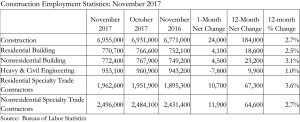
Construction Jobs Numbers Rebound in November
The nation’s construction sector added 24,000 net new jobs in November, representing a 0.3 percent month-over-month increase, according to an Associated Builders and Contractors (ABC) analysis of Bureau of Labor Statistics data released today.
Nonresidential construction employment added 8,600 net new jobs in November, a figure that would have been substantially higher were it not for heavy and civil engineering, which lost 7,800 for the month. In October, nonresidential construction firms shed 3,600 net positions.
The construction industry unemployment rate increased by 0.5 percentage points and now stands at 5 percent. While this increase is likely due to seasonal factors, an increase in the construction industry unemployment rate is not necessarily a bad indicator given ongoing skilled labor shortages. The unemployment rate for all nonfarm industries—a figure that is seasonally adjusted—remained unchanged at 4.1 percent in November and remains at a 17-year low.
“Today’s employment report was quite good,” said ABC Chief Economist Anirban Basu. “The nation added 228,000 net new jobs in November, which makes it the second consecutive strong month for employment growth. Some of this performance may be attributable to interrupted hiring in August and September due to storms. However, for the most part, today’s report is consistent with long-term trends indicating strong demand for human capital and an economy poised to avert a downturn in the near term.”

The labor force participation rate remained unchanged at 62.7 percent, quite low by historic standards. Labor force participation remains low for a host of reasons, including the ongoing large-scale retirement of baby boomers, a significant fraction of whom have skills pertinent to the delivery of construction services.
“Indeed, the nation’s economy is humming,” said Basu “With consumer confidence remaining elevated and wage pressures continuing to build, there is little reason to believe that America’s consumer-led recovery is about to soften. This is good news for construction firms, particularly those that specialize in private construction,” said Basu.
“The wildcard is business investment. If ongoing efforts to deregulate industries are ultimately combined with productive tax reform, the economy could become turbocharged as significant growth in business spending joins existing consumer spending momentum to return the United States to sustained growth of 3 percent or better,” said Basu.

Even in the absence of this long-desired dynamic, the nonresidential building construction sector has managed to increase employment by 3.1 percent during the past year, while the nonresidential specialty trade contractor segment has increased employment by 2.7 percent.
“Unfortunately, investment in infrastructure continues to be inadequate in much of the nation, which represents a significant limit to the upside. Correspondingly, heavy and civil engineering employment is up only 1 percent over the past year,” said Basu.





